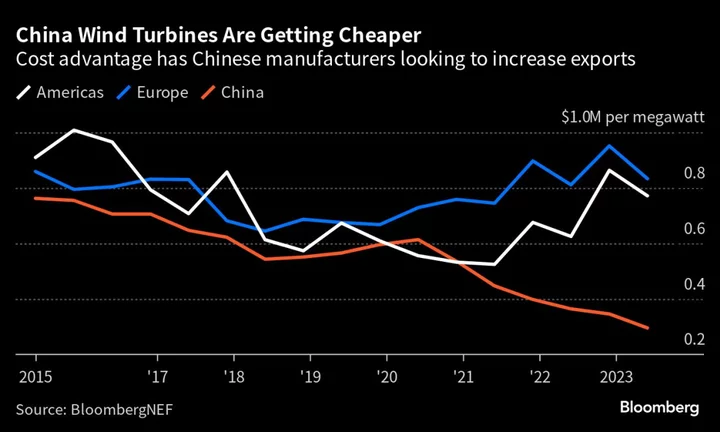China’s wind industry is the country’s latest clean energy sector to see its success draw the attention of foreign trade officials.
The European Union’s acting competition commissioner said last week that wind-power could merit investigation if Chinese firms are deemed to receive too much government aid.
An EU anti-subsidy probe into Chinese electric vehicles is already underway, while its solar panel makers have been targeted by the US for price-dumping, circumventing tariffs and even using forced labor, a claim that Beijing denies. Joint EU-US duties on Chinese steel could also be announced later this month.
Trade tensions are marring what otherwise has been one of the biggest success stories in the fight against climate change — China’s rapid expansion of clean energy and its supply chains. Fatih Birol, executive director of the International Energy Agency, last month cited the “spectacular growth” in solar panels and electric vehicles — both dominated by China — as the primary driver for the world to peak fossil fuel demand this decade.
The EU wants to make itself more self-sufficient in clean tech to avoid the kind of outsourcing to China that happened with its solar sector over a decade ago. It’s also aiming to produce more critical raw materials domestically to avoid over reliance on Beijing. Still, it shouldn’t be forgotten that European countries like Germany and Spain were pioneers of renewable energy subsidies to help those industries at their inception.
Read more: EU Wants to Attract Clean Tech: Here’s What You Need to Know
It’s unclear in any case whether opening an investigation into wind-power would be in the EU’s interests. Commissioner for Energy Kadri Simson wouldn’t rule out a probe while speaking on a panel in Brussels on Monday, while acknowledging that the EU needs more turbines than it’s able to produce through the end of the decade.
“If there is a proof that we are facing dumping measures, then of course we have to address that this is unfair,” she said. “But fair competition is also important for our own industries because there is expectation that in several sectors our companies can be the exporters.”
Simson is in Beijing this week to co-chair the EU-China Energy Dialogue with Zhang Jianhua, chairman of the National Energy Administration.
Domestic Content
Until recently, Chinese wind firms have been content to stay within their domestic market, the world’s largest, with 97% of sales in 2022 going to projects in China, according to BloombergNEF. That’s now changing, as manufacturers increasingly target overseas buyers, offering prices at discounts of about 20% to European and US producers.
Those discounts are possible because of diverging trends in global turbine prices. The end to China’s nationwide subsidies for onshore projects in 2020 pushed developers to press for lower prices, squeezing profit margins. At the same time, China was able to exert more control over material and fuel costs than Europe during last year’s energy crisis by relying on its vast coal reserves, helping turbine makers lower prices even as they soared elsewhere in the world.
China’s national and local governments have myriad ways of supporting companies, from direct investments in firms to preferential land and financing arrangements.
China also helped its wind industry develop during its early stages by promising extra payments above normal electricity rates, guaranteeing projects would be profitable at a time when they were more expensive than fossil fuel alternatives. That created enough demand for turbines, and manufacturers have been able to scale up and lower costs so that building wind generation is now about half the cost of new coal power, according to BloombergNEF.
Low Penetration
Beijing-based Sany Heavy Energy Co. last month announced plans to install two supersized onshore turbines in Germany. Goldwind Science & Technology Co. is looking for projects in Spain, and Mingyang Smart Energy Group is trying to enter the UK offshore market, bne IntelliNews has reported.
Any EU measures to constrain Chinese companies are unlikely to shake things up in the near term, given China’s low penetration of its market. But they would create barriers to competition further down the road, and could potentially choke off a source of growth for Chinese firms.
“Chinese manufacturers are targeting Europe for sure, but their market share remains very small,” said Leo Wang, an analyst with BloombergNEF in Beijing. “Even if an anti-subsidy investigation leads to a tariff on Chinese turbines, it will have very limited impact on the dynamics of the EU wind market.”
An official with industry group China Wind Energy Association declined to comment on a potential probe. Even if an investigation is launched, it’s unclear how it might play out as most of China’s renewable energy subsidies are paid to project developers, not manufacturers, said Dennis Ip, an analyst at Daiwa Capital Markets.
The Week’s Diary
(All times Beijing unless noted.)
Wednesday, Oct. 11:
- China to release September aggregate financing & money supply by Oct. 15
- CCTD’s weekly online briefing on Chinese coal, 15:00
Thursday, Oct. 12:
- EU-China energy dialogue in Beijing
- EU-China Energy Cooperation Platform releases report on net zero carbon infrastructure, 14:00
- China’s monthly CASDE crop supply-demand report
Friday, Oct. 13:
- China inflation data for September, 09:30
- China’s 1st batch of September trade data, including steel, aluminum & rare earth exports; steel, iron ore & copper imports; soybean, edible oil, rubber and meat & offal imports; oil, gas & coal imports; oil products imports & exports. ~11:00
- China weekly iron ore port stockpiles
- Shanghai exchange weekly commodities inventory, ~15:30
Saturday, Oct. 14
- Chilean President Gabriel Boric’s first trip to China begins with events in Shenzhen
On the Wire
The muted market reaction to talk of new stimulus from Beijing suggests investors are skeptical that a round of infrastructure spending would jump start the economy
--With assistance from Kathy Chen.

